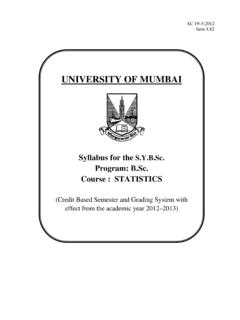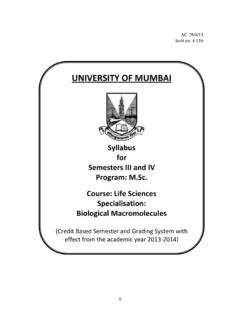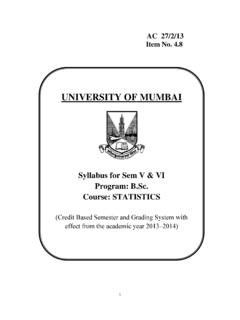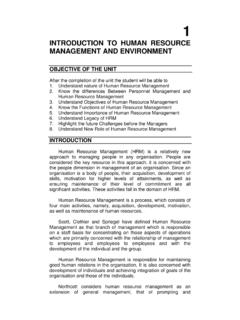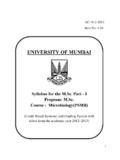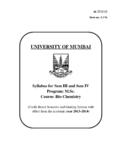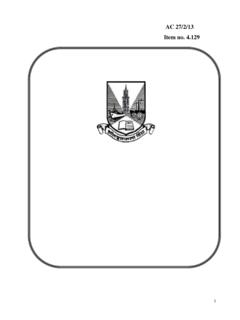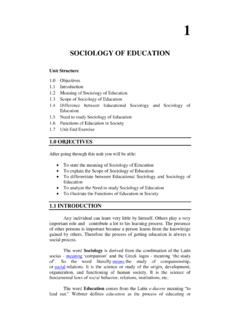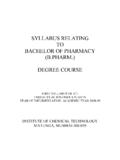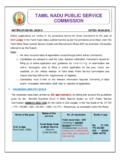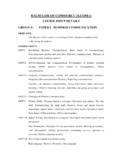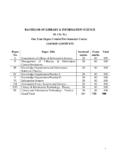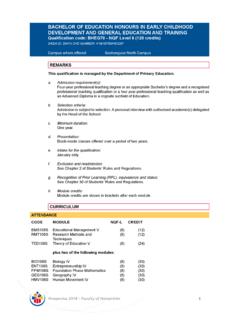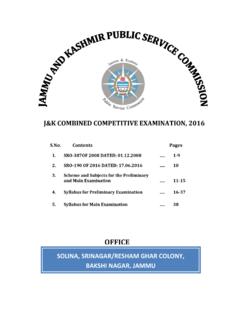Transcription of A credit is generally a value used to measure a …
1 Two Year Revised syllabus 2015-16. Decision of UGC for introducing the semester and choice based credit system in all the central, state and deemed universities and institutions of higher learning in the country under the Eleventh Five Year Plan. (D. O. No. Plan dated January 31, 2008 from the Chairman, UGC). The decision of implementation of credit and Grade point system 10th June, 2010 and subsequently the Management Council gave the concurrence at its meeting held on 18th July, 2010 after suggesting minor changes with the help of Deans of the concerned faculties and resolved to implement it from the Academic year 2011-12.
2 credit system involves breaking down the curriculum into measurable units that can be combined to get a degree/diploma. A credit is generally a value used to measure a student's work load in terms of learning time required to complete course units, resulting in learning outcomes. The number of credits awarded to a learner is determined by credit value or credit Points assigned to a particular course. It is a way of expressing the learner's workload'. (Student's). One (01) credit is fifteen (15) learning hours. Credits once gained cannot be lost. The time duration per credit is divided into two parts.
3 Approximately fifty percent of the time will be spent on class room instructions including student's presentations as prescribed by the university, rest of the time spent for assignments, projects, journal writing, library work, preparations for lessons and examinations etc. will be considered as notional hours. The definitions of the key terms used in the credit based Semester and Grading System Program: Program is set of courses that are linked together in an academically meaningful way and generally ends with the award of a Certificate or Diploma or degree depending on the level of knowledge attained and the total duration of study.
4 Course: A course corresponds to the word subject' used in many universities. A course is essentially a constituent of a program' and may be conceived of as a composite of several learning topics taken from a certain level. All the learning topics included in a course must necessarily have academic coherence that is there must be a common thread linking the various components of a course. A number of linked courses considered together are in practice, a program'. credit Point: credit point refers to the workload' of a learner and is an index of the number of learning hours deemed for a certain segment of learning.
5 These learning hours may include a variety of learning activities like reading, reflecting, discussing, attending lectures/counseling sessions, writing assignments, preparing for examinations, etc. Credits are assigned for a single Course and always pay attention to how many hours it would take for a learner to complete a Single course successfully. By and large a course may be assigned anywhere between 2 to 8. Credits where in one credit is construed as corresponding to 15 hours. ORDINANCES AND REGULATIONS. RELATING TO THE DEGREE OF THE BACHELOR OF. EDUCATION. Two Year Programme From the academic year 2015-16.
6 Title: Bachelor of Education ( ). Duration: Two academic years as credit Based Grading System comprising of Four semesters. The B. Ed programme shall be of duration of TWO academic years, which can be completed in a maximum of four years from the date of admission to the programme. Eligibility: Following candidates are eligible for admission: (a) Candidates with at least 50 % marks either in the Bachelor's Degree (for example , B. Sc, , B. Arch, BMS, BMM, BSW, BE, etc) and/or with 55% marks in the Master's Degree in Sciences /. Social Sciences / Humanity, Bachelor's in Engineering or Technology with specialization in Science and Mathematics or any other qualification equivalent thereof, are eligible for admission to the programme.
7 ( b ) The reservation and relaxation for SC/ ST / OBC / PWD and other categories shall be as per the rules of the Central Government / State Government, whichever is applicable. A Candidate for the admission to degree of education ( ) must fulfill the eligibility criteria as per the directives of Government of Maharashtra from time to time. For the completion of the program the candidate must have: (a) Attended four semesters of the full time Two year programme spread over a maximum period of four years from the date of admission in a College of Education. (b) Attendance: The minimum attendance of student teachers shall have to be 80 % for all course work and practicum, and 90 % for school internship.
8 (c) Completed the Practicum and Internal Assessment assignments of each Theory paper of each year as certified by the Principal of the Institution in which the candidate is studying. The practicum comprises of : - FIRST SEMESTER. Presentation of a book review of educational significance (report to be submitted by the student). Participation in Community work in collaboration with schools/ NGO's (for a period of 1 week). Participation in Co-curricular Activities in college Content test in School Subject opted for Class Test and Essays in each Theory Course. SECOND SEMESTER. Critical analysis of lesson observations: a) shadowing of subject teacher in the School Subject opted for, b) Observation in schools.
9 (Recording of the observations and critical analysis of the same). Participation in Co-curricular Activities in college Critical Analysis of an Educational Film Class Test and Essays in each Theory Course THIRD SEMESTER. Internship for 10 weeks Teaching not less than 26 lessons in the subject pedagogy distributed over different standards from V to XII of recognized secondary and higher secondary Schools/ Colleges selected by the Principal as practicing School/ College. In addition the candidate will have to carry out: - 2 theme based lessons in the above school/ college. - 4 co-teaching lessons with school teachers Literacy/ awareness programs (related to Environment, Population, Health and hygiene, Sociological issues, Financial Literacy, well being, etc) and reports the same.
10 Report on Records maintained in the school. Prepare a Blue print and administration a test in the school subject opted for. Class Test and Essays in each Theory Course FOURTH SEMESTER. Internship for 6 weeks Maintain Reflective journal (for Semester III and Semester IV). 8 Co-teaching lessons with peers Develop learning resources for the school Study the Anecdotal Record/Interview a school student. Organization of Co- curricular activities in school (cultural events, sports, educational game, cultural competitions, etc). Conduct a School based Action Research (d) Should have successfully passed the Theory component of the course in accordance with the University guidelines.

